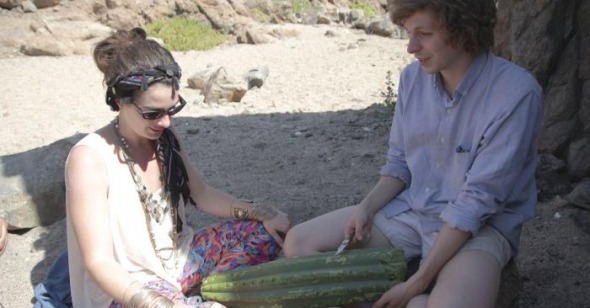Desert Hearts
By Kristi Mitsuda
Crystal Fairy
Dir. Sebastián Silva, U.S., IFC Films
While the limits of Michael Cera’s obliviously adorable moppet act are on full display in Netflix’s recent season of Arrested Development, Sebastián Silva’s Sundance-winning Crystal Fairy provides the actor an opportunity to show off the unexpected and fun flip side of the coin: an obliviously assholish millennial. His Jamie is abroad in Chile (as Cera will be again, in another as-yet unreleased collaboration with Silva, Magic Magic); entitled, self-centered, and arrogant, he is the cliché of the ugly American embodied. At an opening-scene party, he attempts to show off his worldliness by complimenting the cocaine—he’s had really shitty coke and weed while in Chile, see—and, to local friend Champa (Juan Andrés Silva), loudly mocks a girl (a bold Gaby Hoffmann) moving freely to the music. He goes so far as to shout at her that she’s embarrassing herself. To this, the dark-haired dancer—whom we soon learn is the titular character, also American—replies, “We’re all one self, man.”
Digging her response, a high Jamie then cajoles Crystal Fairy into joining him and his friends in their search for San Pedro cactus, the impetus for an upcoming excursion and justification for his heretofore seemingly affected references to The Doors of Perception, now revealed as authentic interest; the boy’s seeking a vision quest, and the plant contains mescaline. But he soon regrets his inebriated invitation when the next day Crystal calls to attend to logistics. Jamie wants to blow her off but is dissuaded by Champa, whose brothers, Lel (JosĂ© Miguel Silva) and Pilo (AgustĂn Silva), round out the road trip crew. The film that follows largely charts the often funny friction between the opposed personalities of Jamie and Crystal Fairy—the former’s aggressive abrasiveness and superficial engagement with the world rubbing up against the latter’s new-age spiritualism (chakras, blessings, and healing work are her forte)—that come off as equally excruciating. A sample interaction: after Crystal Fairy lectures the others about their food choices in an anti-sugar screed, Jamie says to the brothers with no trace of self-awareness, “She’s exhausting,” before delivering a loud aside, “We’re probably gonna need some tampons now that we’re dragging this woman around.”
Crystal Fairy’s own magic trick is that it plays out with a lighthearted ease and charm as beguiling as the main characters are aggravating. As with his breakthrough dark comedy, The Maid (wherein the lead listed in exactly the opposite direction of Crystal Fairy’s—so far withdrawn into herself is she that her personality needs to be coaxed out by another), Silva reveals himself to be a humanist, devoting attention to protagonists another director might dismissively skip over. His nonjudgmental approach is mirrored in this movie by the three brothers, who help balance out the extreme personalities as they extend to the Americans a level of compassion unearned except by a seemingly mature-beyond-their-years understanding of shared basic humanity. And this warmth animates the film with uncommon feeling.
Leading up to the procurement of the San Pedro, Silva employs a roving camera in representation of Jamie’s hot-pursuit twitchiness (possibly compounded by caffeine and other drugs). It’s only once the quintet ingest the cactus on a desert beach and start feeling its effects that the movie seems to settle down into more stillness, which comes as a relief after the manic energy expended. The filmmaker regards the experience with a naturalism and open-mindedness rare in contemporary depictions of hallucinogenic drug use. Think, for example, of recent cinematic stagings in releases like Wanderlust or Death at a Funeral (both British and American versions), where psychedelics serve purely parodic ends. Here, the journey of the drug is the destination. Silva stays away from exaggeration and attempts to render the trip realistically, the initial fear and sickness of drug onset and paranoia, and then the unguardedness, silliness, and exultation as the mescaline takes hold. He also evinces an appreciation for the beauty of this chemical heightening, capturing in slow-motion sequences the group relishing the rush of the ocean while interlacing tiny moments such as Lel hypnotized by the patterns on his palms.
Crystal Fairy’s blithe unfolding is marred only by a conclusion that feels belabored, overly taxed by the prospect of reaching an emotionally coalescent crescendo. As expected, Jamie has a breakthrough moment of empathy for Crystal, but it leads to revelations that seem too sudden and schematic in their heaviness—a disappointment after so many conventions had been skillfully sidestepped. The film might’ve fared better coasting along on its surface explorations, which are far more entrancing than the final capitulation to narrative contrivance. Here it seems to be dutifully striving for a deeper connection, not realizing it’s already reached a unique level of grace in its miniature portraits of human behavior.
